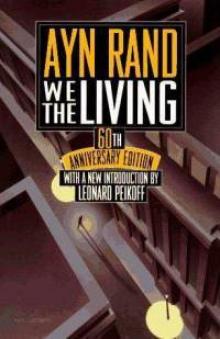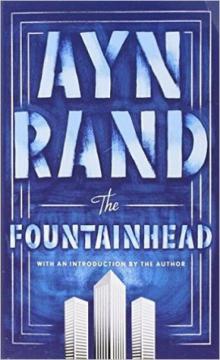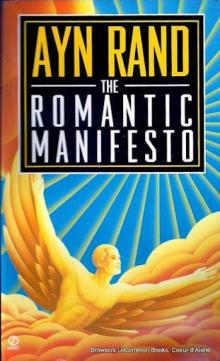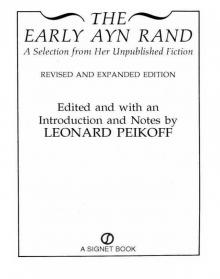The Journals of Ayn Rand Read online
Page 19
If the student intends to become the designer of important public buildings, he should spend a few years at the Ecole des Beaux Arts in Paris. (More rubbish!)Because of their belief in the value of the Beaux Arts training, a group of New York architects who originally studied there, founded the “Society of Beaux Arts Architects” with a working studio, or atelier, where any ambitious architectural student may come and work on problems similar to those of the French Beaux Arts School, under the direction of the Beaux Arts architects themselves, who generously give their time to this work. And every year a “Paris Prize” is awarded, which sends its winner, with all expenses paid, to spend a year in the Ecole des Beaux Arts in Paris.
(Look into this. Sounds perfectly anti-Roark. Try to meet one of them. What prompts such a business?)
The step from draftsman to architect is seldom an easy one. In a small firm a draftsman may be taken into partnership, if his work is valuable; more likely if he can bring with him a “job”—“if through social connections he can develop a client.” With money, he can buy himself into a partnership.
In large offices, where it is more difficult, he may do work in his spare time, working at night or on holidays, if through some personal means he can get a building to design.
Sometimes, if two fellow draftsmen can get work of their own to do, they give up their jobs and set themselves up as architects. If they have no money they must be very economical. [They may set up] a small office, two drafting tables, bought second-hand, and do all their own work. While working on their first “job,” they must do all they can to find another to follow up with.
“Sometimes one plucky fellow alone makes the jump from draftsman to architect in just this way.”
About this particular book: a commonplace, plodding little author, well-meaning, but completely conventional. To wit: the advice about the Beaux Arts School. Equal notice for classical revivals and Frank Lloyd Wright. “Anything goes.” Scholarly and without convictions about it all. Naively funny descriptions of all the jumbled eclectic adaptions of architectural styles in America. Such sentences as “the best French chateau in America,” etc. After listing the English, French, Dutch, Spanish and Italian buildings in this country, he adds quite seriously: “The Floridians have been even more adventuresome in architecture, achieving surprisingly successful adaptations of North African architecture, in stucco houses that are extraordinarily suggestive, in their essentials, of the houses of Tunis or Algiers.” (!)
Note: The peculiar preoccupation of architects such as this author and the previous one with “proportions,” “moldings,” “scholarly faithfulness to Classic examples,” etc. Worrying about every little thing, except the main one—the composition and its meaning as a whole. Isn’t it like the people who worry greatly about fine points of “style” and grammar in literature, without caring what the writing is about? Again, the “how” against the “what.” (Yet, the “what” determines everything else, just as the end determines the means, not vice versa. I do not intend that the end should justify lousy means, either. The “how” should always be worthy of the “what,” but determined by it.)
July 12, 1937
Le Corbusier, Towards a New Architecture.
He claims that the most beautiful forms are the simplest geometrical forms, the easiest to see. (Danger of over-simplification of modem architecture here.) Thus he considers Classic, Egyptian, Roman and some Renaissance architecture good, but Gothic bad, or at least not pure architecture. (Lack of the true principle of Frank Lloyd Wright here.)
Architecture is the first manifestation of man creating his own universe. [...]
There is one profession and one only, namely architecture, in which progress is not considered necessary, where laziness is enthroned, and in which the reference is always to yesterday....
He claims that the terrible houses of today destroy the family, by being unlivable. Advises modem houses to save family life.
He claims that we must establish definite standards for architecture, in order to elaborate these into perfection. (Danger of a new standardization and new set of rules for all architects to follow—just as in the following of old styles.)
Elementary satisfactions—decoration. Higher satisfactions—mathematics. The Parthenon and the automobile—both products of selection.
We must not assert with too much conviction that the masses give rise to their man. A man is an exceptional phenomenon occurring at long intervals, perhaps by chance, perhaps in accordance with the pulsation of a cosmography not yet understood. [...]
Art is this pure creation of the spirit which shows us, at certain heights, the summit of the creation to which man is capable of attaining. And man is conscious of great happiness when he feels that he is creating.
Advocates planned towns. (What will Roark say about that? Give it some thought.)
Interesting book, but too much emphasis on mass-production houses. Beautiful theories—but in practice, in the illustrations of the man’s work, too much standardization, too much reliance on the principle of “the beauty of modern tools,” not enough of that superior architectural beauty which the author himself advocates.
David Gray, Thomas Hastings, Architect.
The most disgusting book that I have read to date. The perfect picture of everything that stands against Roark. To be used plenty, for Peter Keating and all the others, particularly for John Eric Snyte. The perfect set-up of what has made modem architecture impossible. The perfect crystallization of the conventional architect, at the head of the profession, the kind responsible for Architectural Societies and all that prevents real creative genius and fights not to give it a chance. Smug, arrogant in a vulgar way, vain, self-contented, bitter and nasty toward all who are not like them, attacking genius with a phony, angry contempt, but without reasons or explanations, attacking only with ugly adjectives and curses, but never mentioning any valid grounds. [They] theorize in empty talk, seeming to accept all the best teachings of modem architecture and then distorting them by their own petty, silly, preposterous sophistries.
Only actual quotations can do justice to the picture of such an architect as Hastings:The man and the artist seemed inexplicably detached one from the other. So to speak, one never met them both at the same time; and meeting the one gave little clue to the nature of the other.
As artist he was single-purposed, concentrated, intense, withdrawn into himself, obeying the mystic guidance of his genius with an almost ruthless energy and devotion. As a man in his human relations his qualities were those of a lovable child, generous, affectionate, sunny-natured. It was his good fortune never to have grown up in a worldly sense. He believed in everybody, was disposed to like everybody, was troubled by no spiritual questionings. He found the world the best of all possible worlds, and that, though he had worked his way through it from bottom to top by his own talent and industry. In this he was truly an amazing example of the preserving grace of simplicity and love.
Sic!!!
Such damning twaddle is presented in the book in the spirit of the greatest compliment. It speaks for itself—for the man and also for those who admired him.
Hastings had a “salon” that gathered for a “business man’s lunch.” “Charming” informality, “humor” and “quaintness.” Just a nice, big show to yell to the world: “See what lovely, regular fellows we are!” A description of Hastings’ entrance into one of these gatherings:She stopped him with the observation that he never had had an idea except to build his clients a fire house if they ordered a dog kennel. It was their habitual play together and Hastings went on with his part, sputtering protestingly, calling on someone to protect him. As he peered, blinking through his pince-nez and recognized first one friend then another, he gave exclamations of delight and went the rounds with his greetings, pouring out affectionate extravagances, wringing hands, holding Miss Marbury’s and begging her to elope with him.
Lovely? Just a good back-slapper that knew damn well how to get along with his fellow men. It must also be noted that the struggle “from bottom to top” mentioned in the previous quotation was in reality from the security of an established family to his first jobs through the pull and protection of his family’s friends.
Some more about the lunches:Hastings in this milieu was like a boy out of school: gay, irresponsible, affectionate, charming. His old friends all called him “Tommy” and chaffed him incessantly. It was characteristic of the relation between him and those who were fond of him, and he enjoyed it. At each new and affectionate insult he would rock with laughter and mock indignation.
It is characteristic all right.
Hastings entertaining a guest at lunch:It was characteristic of him to make much of the stranger and put him at his ease. First he produced a wire puzzle—he was habitually buying such things from street vendors—and challenged her to take off a ring which was apparently irremovable. When she had given it up, he held the thing below the table with an air of mystery and triumphantly produced it in two pieces. Then he told her his story of the father who asked his advice as to whether his son should embrace architecture or dentistry. At this Dunne observed that if Hastings’ father had consulted a good architect, Tommy might now have been a good dentist.
Shaking with laughter, Hastings went on to explain to [his female guest] that no dentist could have the anxieties of an architect; that when he was a beginner he was always afraid that his houses were going to fall down but now when he saw them again he was afraid that they weren’t.
Such wit!
Contrast this—if the mere rapprochement of the two in one thought is not too much of a sacrilege—with the chastity of a Howard Roark. [...]
No early signs of his [aptitude for] architecture, except a “talent for drawing.” At seventeen,
he gave up his preparation for college and entered the offices of a firm of furniture makers and interior decorators, as student and draftsman. His first solo assignments were rooms to redecorate. He attended a “Sketch Club,” heard talk of the Paris Ecole des Beaux Arts and decided to go there. Went to Paris at age twenty. He was “affectionate, social, fun-loving, and boyishly exuberant.... Though very young he appeared to escape those sentimental and passionate predilections which blind the mind to work of equal merit but of a different kind.” He liked everything. No ideas of his own, no positive taste, no artistic, creative convictions. The above quotation is also given in the book as a compliment.
He studied at the Ecole for four years. Returning to America, at age 24, he entered the office of McKim, Meade and White as a draftsman. Here he met John M. Carrere, another Ecole man, and their friendship led to the forming of a partnership a year later. Hastings did the designing and Carrere handled the business side. His first big commission, which warranted his going into business for himself, was for a hotel in Florida, given to him by a friend and parishioner of his father. He built the hotel in the Spanish Renaissance style.
Hastings’ opinions:At any given point in this historic evolution he saw the architect building in the manner which his own period had devised rather than selecting styles from the past. Architecture, therefore, had ever been modem and of its own time.
Fine, but here is the conclusion:He maintained that as far as modem architecture could have a name and recognized style, it must be Renaissance; for our life and civilization were still motivated by the forces which brought about the Renaissance. Therefore, the modem architect must be logically a Renaissance architect and such he conceived himself to be.
Best example of sophistry I’ve ever heard. [Ralston Holcombe expresses this view in the novel.]
In 1897 (at the age of 37) he won the competition for the construction of the New York Public Library. He wanted to make it more monumental than the original utilitarian plan.
The measure of this determination and tenacity is the fact that he wrung upwards of nine million [dollars] from a not overwilling city government, instead of two and one half million.... Its Renaissance elevation was to him equally logical and essentially modern. As he saw it, the aesthetic treatment lay inevitably in those principles of design and ornament developed since the revival of learning and the arts.... How the self-styled modernist who condemns this work as academic, who denies the heritage of the past and exalts originality above beauty, would have conceived an appropriate monumental repository for the printed record of man’s intellectual achievement is an interesting though perhaps not important speculation.
Here speaks arrogant mediocrity. Note the constant attacks on originality both from Hastings and from his enthusiastic admirer, the author of this book. Such little phrases as “exalting originality above beauty.” Nothing is ever said about originality that is beauty. [...]
During the years of work on the Library, Hastings had more than two hundred other commissions. He specialized in “monumental” works. Built a great deal for Fairs and Expositions. The most important of his works in this period was the New Theater in New York. He also won this in a competition. (Remember what Frank Lloyd Wright said about competitions! This is the best supporting evidence.)
“As he matured and gained authority, the teacher and evangelist in him became more evident.” He went to great lengths in preaching his architectural ideas. He also went heavily for “public service.” In 1910 President Taft appointed him one of the original members of the National Commission of Fine Arts. “This body was to exercise a general supervision of the National Government’s activities in the field of aesthetics and in particular of the architectural development of the National Capital.” (A fine example of what happens when National Governments go in for art.) In this capacity, Hastings had a great deal to do with the building of Washington, D.C. [...]
“He regarded architects who ignored tradition as uneducated, which was usually true, or as actuated by a frivolous and vain desire to be original at any cost.” (Mediocrity going snobbish and on the defensive.) Speaking of a Renaissance architect, he said: “It would have been impossible for him actually to define the style of his own period. That is for us, his successors, to do.” (Fine consciousness in creation!) An architect, he goes on to explain, [should] study the best that he can find in the past and use it to solve his modem problems. (Very creative!)
Hastings at fifty:In 1922 he was awarded the King’s Medal by the Royal Institute of British Architects, bestowed hitherto upon but two Americans, Richard Hunt and Charles McKim. He was a fellow of the American Institute of Architects, President of the Society of Beaux Arts Architects, member of the Architectural League of New York and of the American Academy of Arts and Letters. He had served seven years as a member of the National Fine Arts Commission. France had awarded him the Legion of Honor. He was continually consulted by the municipal authorities of New York in regard to its architectural projects and executed various public commissions.
Here is the complete picture of society and collectivism at work. Who gave medals and titles to Louis Sullivan or Frank Lloyd Wright? All this was going on in the same years when Sullivan was dying of a broken heart because his country would not recognize him, not even give work to him. If this doesn’t damn society, what can? [...]
Hastings’ views: How near can we come to determining what is modem architecture, or what is the proper style of architecture for our time? Surely it should not be the deplorable creation of the would-be style-inventor, or that of the illogical architect, living in one age and choosing a style from another.
The important and indisputable fact is not generally realized that from prehistoric times until now each age has built in only one style of architecture. In each successive style there has always been the distinctive spirit of the contemporaneous life from which its roots drew nourishment. But in our time, contrary to all historic precedent there is a confusing variety of styles. Why should we not have one characteristic style, expressing the spirit of our own life? Has the world of art always been in the wrong until today? Does our actual work warrant the conceit of the assumption that we know more about it than has ever been known at any time or by all artists for the last three thousand years? History and the law of development alike demand that we build as we live.
(Note the awful borrowing of modern ideas, only to lead up to such conclusions as he makes.)
He further claims that architecture always follows the political, religious, economic and other cultural developments of history, i.e., it follows the “spirit of the age.” And then:Therefore, before we can in any way indicate what style properly belongs to our time, we must first realize our historic position and the distinctive characteristics of our civilization. What determining change have we had in the spirit and methods of life since the revival of learning and the Reformation to justify us in abandoning the Renaissance, or in reviving medieval art, Romanesque, Gothic, Byzantine, or any other style?
(What indeed? This passage beats them all!)
Out of these necessities of the times the Renaissance style was evolved, and around no other style have been accumulated such vast stores of knowledge and experience, under the lead of the great masters of Europe. Therefore, whatever we now build, whether church or dwelling, the law of historic development requires that it be Renaissance.
All branches of art have contributed to the embellishment of this style; no other is so thoroughly expressive of the artistic feeling of the age in which we live....
We should study and develop the Renaissance and adapt it in our modem conditions and wants, so that future generations can see that it has truly interpreted our life. We can interest those who come after us only as we thus accept our true historic position and develop what has come to us. Without this we shall be only copyists or be making poor adaptations of what never was really ours.

 Anthem
Anthem We the Living
We the Living Atlas Shrugged
Atlas Shrugged The Fountainhead
The Fountainhead The Romantic Manifesto: A Philosophy of Literature
The Romantic Manifesto: A Philosophy of Literature The Classic Sci-Fi Collection
The Classic Sci-Fi Collection The Early Ayn Rand
The Early Ayn Rand